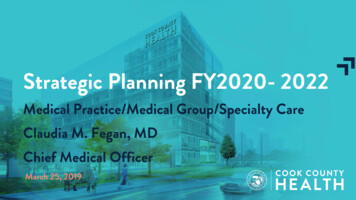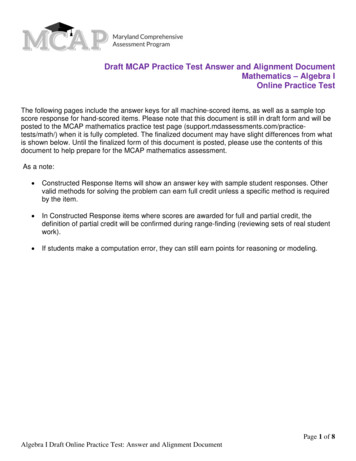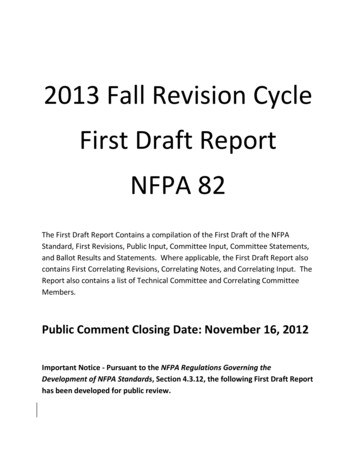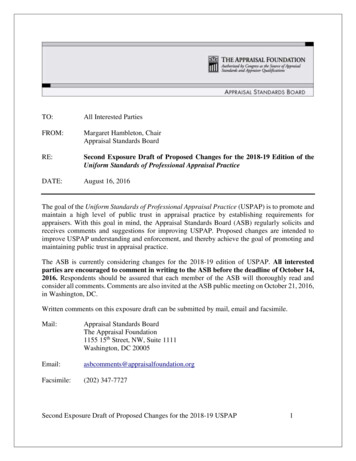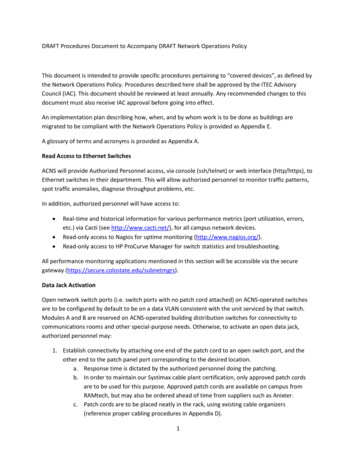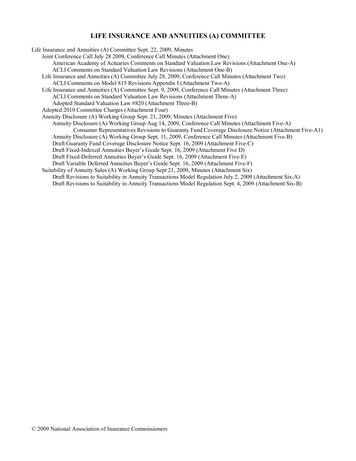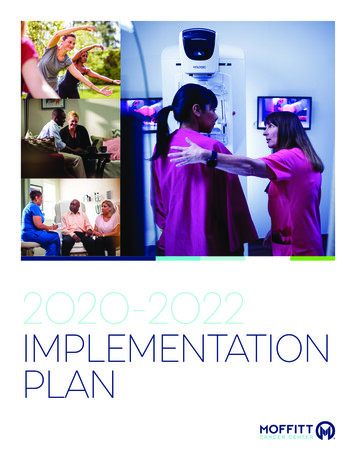
Transcription
2O2O-2O22IMPLEMENTATIONPLAN
Table of ContentsMoffitt Cancer Center Overview . 1About Community Health Needs Assessment . 1Impact of Previous CHNA . 12019 Community Health Needs Assessment . 3Community Served . 3Approach and Process. 3Health Need Priorities – Identification and Ranking Process . 52020-2022 Implementation Plan .6Community Resources . 7
Moffitt Cancer Center OverviewMoffitt Cancer Center (Moffitt) is a free-standing cancer center and tax-exempt corporation as described in IRS Section501(c)(3). Moffitt opened in 1986 and is named for H. Lee Moffitt, a former Speaker of the Florida House ofRepresentatives, who spearheaded the effort to create a cancer center. Moffitt’s sole mission is to contribute to theprevention and cure of cancer. The Tampa-based facility is one of only 50 National Cancer Institute-designatedComprehensive Cancer Centers, a distinction that recognizes Moffitt’s scientific excellence, multidisciplinary research,and robust training and education. Moffitt is a major economic engine that employs more than 6,000 people across fourcorporate entities. Patients come from all 67 Florida counties, all 50 states and over 133 countries. Moffitt also has awide range of outreach and community service activities and community hospital and academic partner networksthroughout Florida, the nation, and the world.About Community Health Needs AssessmentThe Patient Protection and Affordable Care Act (PPACA) of 2010 established new requirements for all non-profit501(c)(3) hospital organizations to 1) conduct a community health needs assessment (CHNA) every three years, and 2)adopt an Implementation Plan (IP) to meet needs identified in the assessment.A community health needs assessment is a systematic process involving the community. The goal is to 1) identify andanalyze community health needs and assets, 2) to prioritize these needs, and 3) plan and act upon significant unmetcommunity health needs. The implementation plan outlines the hospital’s plan for addressing community health needs.This process lays the groundwork for developing programs and services for Moffitt that will positively impact the healthand well-being of the community.Impact of Previous CHNA PrioritiesIn 2016, Moffitt’s last CHNA determined two priority needs to address: Access to Care and Cancer Screening/Prevention.Table 1 includes a summary of how the priority areas have been addressed since the last CHNA.1
Table 1. 2016 Implementation Plan ProgressPRIORITYNEEDGOALACCESS TO CAREImprove access to healthcare services for those inneed within the primaryservice areaProvide increasednavigation services forpatients and communitymembersSCREENING ANDPREVENTION SERVICESSupport communityadvocacy to increaseaccess to transportation2Increase awareness andeducation of cancerprevention and screeningEliminate existinginternal barriers for beingscreenedProvide increased and/orimproved screening andprevention services forlung cancer, breastcancer, prostate cancer,and colorectal cancerACCOMPLISHMENTSA web-based Community Resource Directory was developed to provide teammembers a tool to navigate patients and community members in need of services.Nearly 100 organizations are included. From July 2017 to May 2019, there were 165page views.A Community Navigator was hired as part of a one-year pilot grant from July 2016 toApril 2017. Nearly 50 community members were assisted with schedulingappointments, requesting Language Services, coordinating transportation, lodging,and other needsTwo full-time nurse Patient Navigators were hired in April 2017 to assist patients 130 adolescent young adult patients and 513 patients in the Head and Neck Clinicwere navigated Navigated AYA Patients in Sarcoma have a higher average number of patienteducation encounters (5.7 education events per patient) compared to nonnavigated AYA sarcoma patients (3.5 education events per patient) Retention rate (treated vs. untreated) for navigated patients in the Head & NeckMultiD clinic has increased since navigators started (baseline: 56% treated; sincenavigation: 80% treated)Though the development of an online training was included in the ImplementationPlan, it was determined not to develop it since George Washington University hasalready developed a tool. Moffitt’s Patient Navigators completed The GWUOncology Patient Navigator Training.Moffitt solicited input from employees to give the Hillsborough Area RegionalTransit (HART), the county’s public transportation system, feedback regarding theirproposed bus route changes.Along with other businesses, Moffitt donated 25,000 to HART to help fund a newbus route system, The Uptowner, throughout the university area.Public Service Announcements (PSA) were developed for breast, lung, colorectal,and prostate cancers and were promoted on both TV broadcast and digitalplatforms. Campaign media analytics from September 2017 to March 2018: TV spots – 719;Digital impressions – 1,869,143; Clicks – 9,241A website (www.canscreen.org) was created for viewers to obtain more informationabout cancer screenings and a toll free number was included for individuals to callthe National Cancer Institute with questions. Website – 3,728 total sessions; Telephone – 33 callsMoffitt organized nearly 450 cancer screening/prevention education workshops andevents, serving over 10,000 community members.Moffitt faculty held five Facebook live events to discuss cancer prevention andscreening and answer questions from the audience. The events reached over 10,000unique individuals online.Integrated a Resource Specialist position within the community outreachdepartment to help reduce scheduling barriers for uninsured patients who receiveda screening voucher.Moffitt offers screening vouchers to uninsured patients to improve screening andprevention services for lung cancer, breast cancer, prostate cancer, and colorectalcancer. Each voucher has specific eligibility criteria. From 2017-2019: over 1,800 mammography vouchers and over 200 prostatevouchers were offered to uninsured patients. From 2018-2019: 11 lung vouchers,33 colorectal vouchers were offered to uninsured patients
2019 COMMUNITY HEALTH NEEDS ASSESSMENTCommunity servedMoffitt’s primary service area for this assessment comprises of Hillsborough, Pasco, Pinellas, and Polk Counties locatedin west central Florida. Over half of Moffitt’s patient population comes from these four counties. The major populationhub of the primary service area is Hillsborough County, home of the city of Tampa and Moffitt Cancer Center.Approach and ProcessMoffitt recognizes that the community’s health is affected by multiple factors. This CHNA analyzes an array of clinical,social and health-related data. The 2019 CHNA used a collaborative approach with Moffitt Research faculty andcommunity stakeholders. The data collected incorporated three different sources: 1) publically-available data on social,economic, and health issues; 2) phone interviews with community stakeholders; and 3) online survey of communityresidents.Moffitt hired Carnahan Group, Inc. to perform community stakeholder phone interviews. A total of 39 externalcommunity stakeholders and 13 internal Moffitt staff interviews were conducted between January 28, 2019 and March7, 2019. Table 2 lists the organizations and Moffitt departments who participated in an interview.Table 2. Community Stakeholder InterviewsCommunity Stakeholder OrganizationsAllegany Franciscan Ministries, Tampa Bay RegionGulf Coast North Area Health Education CenterAmerican Cancer SocietyHaitian AssociationAngels Care Center of EloiseHillsborough County Health Care PlanBayCareHispanic Services Council-Healthy Living ProgramsCatholic Mobile Medical ServicesIndigent Health CareCity of St. PetersburgLake Wales Free ClinicCommunity Health Centers of PinellasLakeland Regional HospitalCrisis CenterMetropolitan MinistriesDesoto County Board of County CommissionersPremier Community Healthcare GroupDivision of Human Services, Pasco CountySt. Petersburg Free ClinicFaces of Courage FoundationSuncoast Community Health CentersFamily Healthcare FoundationTampa Family Health CentersFarmworker Self HelpTampa General HospitalFlorida Department of Health-Hillsborough CountyTampa YMCAFlorida Department of Health-Pasco CountyUnited Way SuncoastFlorida Department of Health-Pinellas CountyUniversity Area Community Development CorporationFlorida Department of Health-Polk CountyUSF & Latinos Unidos por Un Nuevo Amanecer, Inc.Foundation for a Healthy St. PeteUSF College of Public HealthGood Samaritan Health ClinicUSF Office of Community Engagement & PartnershipsMoffitt DepartmentsMoffitt Program for Outreach, Wellness, Education, andBreast Program DivisionResourcesClinic AdministrationNursing Practice, Education & Clinical EffectivenessClinical Trials CorePatient and Advisory Executive ProgramHospital AdministrationSocial WorkInternational & Executive Referral ServicesTampa Bay Community Cancer NetworkMarketingU54 Partnership3
YouGov, Inc. was hired as a consultant to implement an online community survey. The responses were weighted basedon census data to reflect the area population. The survey was available in both English and Spanish. There were 740participants from the primary service area. Table 3 shows the county representation of the participants and Figure 1 is amap that displays the distribution of the participants by zip codes. The red star in the figure represents where Moffitt islocated.Table 3. Online Community Survey ParticipantsCountyHillsboroughPascoPinellasPolkN 740333 (45.0%)113 (15.3%)185 (25.0%)109 (14.7%)Figure 1. Zip Code Distribution of Survey Participants4
Health Need Priorities - Identification and Ranking ProcessThere were 10 major needs identified from the CHNA that fell into four major categories (Figure 2). The four categoriesare Access to Care, Health Behaviors, Cancer Screening, and Cancer Beliefs.Figure 2. Identified Health NeedsAccess to Care Healthcarenavigation Transportation SocialDeterminants ofHealthCancerScreeningHealth Behaviors Smoking Physical Inactivity Alcohol Use Obesity HPV vaccinationCancerBeliefsOn May 6, 2019, a meeting was held with Moffitt staff and community partners to review the CHNA results and topresent the identified priority areas. There were seven community partners from health clinics, academia, andcommunity-based organizations and 16 Moffitt staff members, representing a variety of departments in attendance. Theidentified health needs were placed on separate wall charts and displayed throughout the meeting room. Eachparticipant had up to five “sticky dots” they could use to vote on their perceived most-pressing health needs. Theprioritizing criteria were based on alignment to Moffitt’s mission and resources, the ability and feasibility to address aparticular health need, and the resulting impact and benefit to the community. Each participant could place all or part oftheir allotted dots on a single need or allocate them to multiple needs according to their own perceptions. Following theinitial vote, participants regrouped to discuss how the votes were distributed. Based on the discussion, the groupdecided on the top four priorities to address in the Implementation Plan: Healthcare Navigation, Transportation, CancerScreening, and HPV Vaccination.It was decided not to address the other identified needs (social determinants of health, smoking, physical inactivity,alcohol use, obesity, and cancer beliefs) because they either do not align with Moffitt’s mission and vision, they arealready being addressed internally in other capacities, or other entities are better equipped to address them.5
FY2020 – 2022 Implementation PlanThe Implementation Plan was adopted by the Hospital Board of Directors on September 25, 2019. Table 4 displays thegoals and strategies for the 2020 – 2022 Implementation Plan.PRIORITY AREATable 4. 2020-2022 Implementation PlanGOALSTRATEGYCollaborate with local, African American/Black sorority chapters to providebreast cancer screening education to women 40 years and olderPartner with Physician Relations to disseminate cancer screeninginformational materials (for both healthcare providers and patients) tocommunity clinics and physician officesPromote cancerscreening among ageeligible adults throughpartnerships andeducationOrganize colorectal awareness event to educate community aboutcolorectal screening during MarchDeliver cancer screening education to the community through MoffittOutreach groups (e.g., M-POWER, LATTE, TBCCN, etc.)Educate eligible Survivorship Clinic patients about cancer screening andrefer to appropriate screenings as necessaryDistribute Public Service Announcements about breast, colorectal,prostate, and lung cancer screenings on digital and broadcast platformsCANCERSCREENINGCollaborate with community partners to educate men about prostatecancer and PSA testingProvide screening vouchers to uninsured individuals who qualify forbreast, prostate, lung, and colorectal cancer screeningsLink eligible patients toscreening services forbreast, cervical,colorectal, lung,prostate, and skincancersConduct NCI’s Screen to Save CRC research that links patients to FIT testsand follow-up care through a collaboration with Federally Qualified HealthCentersLeverage the efforts of the Center for Immunization and InfectionResearch in Cancer (CIIRC) and the Office of Community Outreach,Engagement, & Equity (COEE) to screen women for cervical cancer atFederally Qualified Health CentersHost breast cancer screening events to screen women during extendedclinic hours at least twice per yearDeliver skin cancer screenings in the community through the Mole PatrolprogramHPVVACCINATION6Increase awareness andeducation of HPVassociated cancers andvaccination uptakeOrganize an event targeting providers and health insurance companies toincrease awareness of HPV-related cancers, testing, and vaccinationsurrounding the HPV Awareness Day on March 4th
Table 4. 2020-2022 Implementation Plan (Cont.)HEALTHCARENAVIGATIONTRANSPORTATIONIncrease the number of newpatients receiving navigationservicesExpand navigation services to more clinics throughout MoffittProvide navigation services forcommunity members accessingcancer servicesUtilize a Community Navigator to assist community memberswith access to cancer screening and treatment resourcesReduce transportation burdensfor patients accessing cancerservicesOperate a mobile bus to provide access to screening and cancerprevention education services to rural or underservedcommunitiesCoordinate at least 4 Community Day events per year that willprovide transportation services for women to be screened forbreast cancer at MoffittCommunity ResourcesThere are ample resources throughout the community to help address these needs. Table 5 lists these important andvaluable organizations that can potentially help Moffitt address the identified health needs.Table 5. Community Clinics and OrganizationsAllegany Franciscan MinistriesFarmworker Self HelpAmerican Breast Cancer FoundationAmerican Cancer SocietyAmerican Red CrossBeth-El MissionBlack Nurses Association—Clearwater/St. Petersburg ChapterBrandon Outreach ClinicBRIDGE ClinicFaces of Courage FoundationFamily Healthcare FoundationFlorida BlueFlorida Breast and Cervical CancerEarly Detection ProgramFlorida Department of HealthFlorida Department of Motor Vehiclesand Highway SafetyFloyd Kelton Health CenterFront Porch CDA, Inc.Calvary Community ClinicFoundation for a Healthy St. PeteCatholic Mobile Medical ServicesGood Samaritan Health ClinicCentral Florida HealthcareClearwater Free ClinicCommunity Health Centers of PinellasCrisis CenterGulf Coast North AHECHaitian AssociationHealthcare for Homeless VeteransHillsborough Area Regional TransitHillsborough County Health & SocialServicesHillsborough County Latino CoalitionAngels Care Center of EloiseDover Health CenterEquality Florida7Hillsborough Metropolitan Planning forTransportationHispanic Leadership CouncilHispanic Services CouncilHPV Awareness & Action CoalitionHumanaIQuit with AHECJudeo Christian Health ClinicLa Clinica GuadalupanaLake Wales Free ClinicLatinos Unidos por Un NuevoAmanecerLee Davis Neighborhood Service CenterLeukemia & Lymphoma SocietyLifePath HospiceMeals on WheelsMedicaid Area 6 Field OfficeMetropolitan MinistriesPartnership to Immunize Teens and
Children against HPVTable 5. Community Clinics and Organizations (Cont.)Pinellas County Health ProgramPinellas Suncoast Transit AuthorityPlant City Health CenterPlant City Neighborhood ServiceCenterPremier Community HealthcareGroupREACH UP, Inc.Red Crescent Medical ClinicRedlands Christian MigrantAssociationSalvation Army Family ServicesProgramSeniors in Service8Sister’s Surviving Breast CancerSouthShore Community ResourceCenterSt. Andre Free ClinicTampa Bay Black Chamber of CommerceTampa Caribbean Cancer Health InitiativeSt. Petersburg Free ClinicUnited WayTampa Family Health CentersSuncoast Community Health CentersSunshine LineSusan G. Komen for the Cure FloridaSuncoastUniversity Area Community DevelopmentCorporationUniversity of South FloridaWe Care of Polk CountyWest Central Florida Agency on Aging,Inc.Tampa Bay Healthcare CollaborativeWest Tampa Health CentersTampa Bay Area RegionalTransportation Authority (TBARTA)YMCA SuncoastSulphur Springs Health Center
A community health needs assessment is a systematic process involving the community. The goal is to 1) identify and analyze community health needs and assets, 2) to prioritize these needs, and 3) plan and act upon significant unmet community health needs. The implementation plan outlines the hospital's plan for addressing community health needs.

